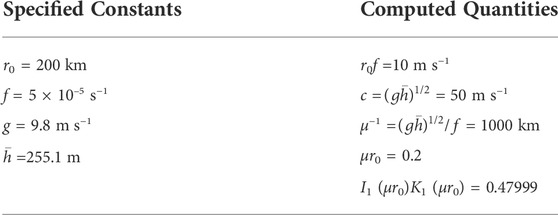- Department of Atmospheric Science, Colorado State University, Fort Collins, CO, United States
The problem of tropical cyclone rapid intensification is reduced to a potential vorticity (PV) equation and a second order, inhomogeneous, partial differential equation for the azimuthal wind. The latter equation has the form of a Klein-Gordon equation, the right-hand side of which involves the radial derivative of the evolving PV field. When the PV field evolves rapidly, inertia-gravity waves are excited at the edges of the evolving PV structure. In contrast, when the PV field evolves slowly, the second order time derivative term in the Klein-Gordon equation is negligible, inertia-gravity waves are not excited, and the equation reduces to an invertibility principle for the PV. The above concepts are presented in the context of an axisymmetric shallow water model, in both its linear and nonlinear forms. The nonlinear results show a remarkable sensitivity of vortex intensification to the percentage of mass that is diabatically removed from the region inside a given absolute angular momentum surface.
1 Introduction
While modern numerical weather prediction has produced significant skill in forecasting tropical cyclone tracks, the forecasting of rapid intensification remains an important challenge (DeMaria et al., 2014). The status of present observational, theoretical, and numerical modeling efforts to improve intensity forecasting can be found in the special collection of thirty articles that have appeared recently in five of the journals published by the American Meteorological Society (see the Doyle and Ferek, 2017, reference for the website that describes this special collection associated with the Tropical Cyclone Intensity Experiment). A concise and excellent review of much of this previous work can be found in Martinez et al. (2019). The present paper explores some of the theoretical aspects of the rapid intensification problem. In particular, this paper discusses how the problem of tropical cyclone intensification can be reduced to the solution of a coupled pair of partial differential equations—a first order equation for the time evolution of the potential vorticity (PV) field, and a second order, Klein-Gordon equation for the evolution of the rotational wind field. In many interesting cases the potential vorticity equation can be solved analytically and the result used as a forcing term in the Klein-Gordon equation. Examples of this approach, in the case when the Klein-Gordon equation reduces to an elliptic invertibility principle, are given in Schubert and Alworth (1987) and Möller and Smith (1994).
The forcing term in the Klein-Gordon equation can be especially large at the edges of an evolving PV structure. When this forcing effect varies slowly in time, the second order time derivative term in the Klein-Gordon equation can be neglected, which converts this hyperbolic equation into an elliptic, PV invertibility principle. When the forcing does not vary slowly in time, the second order time derivative term must be retained and the Klein-Gordon equation maintains its hyperbolic character, thereby describing both the balanced flow and the generation and propagation of inertia-gravity waves. These basic concepts are presented in the simple context of the axisymmetric shallow water model (Section 2), where curvature effects and gradient balance come into play. In the linear case (Section 3), the primary results are the PV solution, given in Eq. 8, and the linear Klein-Gordon equation for v (r, t), given in the middle entry of Eq. 11, or the linear invertibility principle for vb (r, t), given by the middle entry of Eq. 12. These linear results are generalized to the nonlinear case through the use of a Lagrangian description of the flow (Section 4). In the nonlinear case, the primary results are the PV solution, given in Eq. 21, and the nonlinear Klein-Gordon equation for V (R, τ), given by Eq. 24, or the nonlinear invertibility principle for Vb(R, τ), given by Eq. 26. Solutions of the nonlinear problem illustrate how rapid intensification can occur when a large percentage of the original lower tropospheric mass inside a given absolute angular momentum surface is diabatically removed via eyewall convection.
2 Shallow water model
Consider the inviscid, axisymmetric, nonlinear shallow water equations
where u (r, t) is the radial velocity component, v (r, t) the azimuthal velocity component, h (r, t) the fluid depth, g the acceleration of gravity, f the constant Coriolis parameter, (D/Dt) = (∂/∂t) + u (∂/∂r) the material derivative, and S (r, t) the specified mass sink. The potential vorticity principle associated with Eq. 1 is
with the constant
which we can regard as a coupled pair of equations for u (r, t) and v (r, t) if P (r, t) is regarded as known from the solution of the PV principle (Eq. 2). Taking D/Dt of the second entry in Eq. 3 and using the result to eliminate Du/Dt from the first entry, we obtain
It is tempting to regard Eq. 4 as a nonlinear Klein-Gordon equation for the single variable v (r, t), with a time dependent forcing term that is proportional to the radial derivative of the potential vorticity. However, it is important to note that the variables u (r, t) and h (r, t) have not been completely eliminated from Eq. 4, with u (r, t) appearing in the D/Dt operator. In Section 4 we discuss the transformation of Eqs 2–4 to a Lagrangian coordinate, which simplifies the material derivative D/Dt to a local derivative. This not only simplifies the (D/Dt)-terms in Eqs 2–4, but also allows for time integration of the potential vorticity equation (Eq. 2), thereby making the forcing term in Eq. 4 a known function. If the forcing term varies slowly enough in time, the term in Eq. 4 involving D/Dt becomes negligible, so that the diagnostic equation for the gradient balanced wind vb (r, t) is
which is the shallow water version of the nonlinear invertibility relation discussed by Hoskins et al. (1985). However, before discussing the nonlinear problem, we consider in Section 3 the linearized version of the shallow water dynamics (Eq. 1). Although it is limited to weak vortices, the linear analysis of Section 3 provides a useful guide to the nonlinear analysis of Section 4.
Although the analysis presented here is in the context of the shallow water equations, a more general interpretation is that these equations approximately describe the dynamics of an atmospheric layer confined between two isentropic surfaces. The analogy is as follows. When there is a mass sink in the shallow water continuity equation, the two isentropic surfaces bounding the layer should be regarded as lower tropospheric surfaces (e.g., with the layer defined by 320 ≤ θ ≤ 325K). In contrast, when there is a mass source, the two isentropic surfaces should be regarded as upper tropospheric surfaces (e.g., with the layer defined by 355 ≤ θ ≤ 360K). This interpretation is justified by noting that the shallow water continuity equation in the independent variables (r, t) and the continuity equation for a stratified hydrostatic model in the independent variables (r, θ, t) can respectively be written as
where σ = −(1/g) (∂p/∂θ) is the pseudodensity, p is the pressure, θ is the potential temperature, and
3 Linear dynamics
As a guide to the nonlinear analysis of Section 4, let us first linearize the system Eq. 1 about a state of rest with constant mean depth
where
In order to better understand the stationary and oscillatory solutions of the unforced version of Eq. 7, assume the solutions are separable in r and t, with the time dependent part given by eiωt, where ω is the frequency of oscillation. It can then be shown that the radially dependent part of h′ satisfies an order zero Bessel equation and the radially dependent parts of u and v satisfy order one Bessel equations (for further discussion, see Schubert et al., 1980). In other words, we can simply begin with the assumed separable forms
The three eigenvectors corresponding to the three eigenvalues ω0, ω1, ω2 are
where
Single, independent, second order partial differential equations for u (r, t), v (r, t), and h′(r, t) can be found. The easiest to derive is the equation for the divergent component u (r, t), which can be found by taking ∂/∂t of the radial momentum equation and then using the other two equations to eliminate ∂v/∂t and ∂h′/∂t. Then, including boundary and initial conditions, the complete linear problem for the radial flow is given in the first entry of Eq. 11. Since the rotational wind component v (r, t) plays such a central role in tropical cyclone dynamics, the single partial differential equation for v (r, t) is of particular interest. This equation can be obtained by taking (∂/∂t) of the v-equation in Eq. 7, then using the u-equation to eliminate (∂u/∂t), and finally using the second entry in Eq. 8 to eliminate h′. Then, including boundary and initial conditions, the complete linear problem for the azimuthal flow is given in the second entry of Eq. 11. Similarly, and again making use of the second entry in Eq. 8, we can derive the single partial differential equation for h′(r, t), which is given in the third entry of Eq. 11. To summarize, the linear primitive equation problems for u (r, t), v (r, t), and h′(r, t) as independent equations are as follows:
Equations of the type Eq. 11 are often referred to as linear, inhomogeneous, Klein-Gordon equations (Whitham, 1974), or, in the context of electromagnetic theory, as equations of telegraphy (see Cahn Jr, 1945, and sections 4.10 and 5.6 of Copson, 1975). See Supplementary Appendix A for historical notes on the Klein-Gordon equation. The initial conditions listed in Eq. 11 guarantee that the evolving flow results entirely from the forcing S (r, t). Note that the three equations in Eq. 11 contain time-dependent inhomogeneities that depend on the forcing. For the idealized forcing given below in the first entry of Eq. 13, P′(r, t) grows as shown in the second entry of Eq. 13, so that |∂P′/∂r| at the PV edge increases with time and inertia-gravity waves can be excited there. Thus, more generally, the inner and outer edges of a PV annulus can be regions for the generation of inertia-gravity waves. Since the three Klein-Gordon equations in Eq. 11 are linear, they can be solved by transform methods, e.g., Laplace transforms in time or Hankel transforms in radius. The Hankel transform solution of the Klein-Gordon equation for v (r, t) is discussed in Supplementary Appendix B.
When the forcing is slow enough, the pressure field and the azimuthal wind field remain close to a state of balance, so that the radial wind equation could be discarded and replaced by
where μ = f/c is the inverse of the Rossby length.
In order to provide examples of the solutions of the linear balanced flow problems (Eq. 12), we now assume that the mass sink S (r, t) vanishes for r > r0 and is horizontally uniform for r ≤ r0, where r0 is a specified constant. The time dependence of the mass sink is assumed to be
where
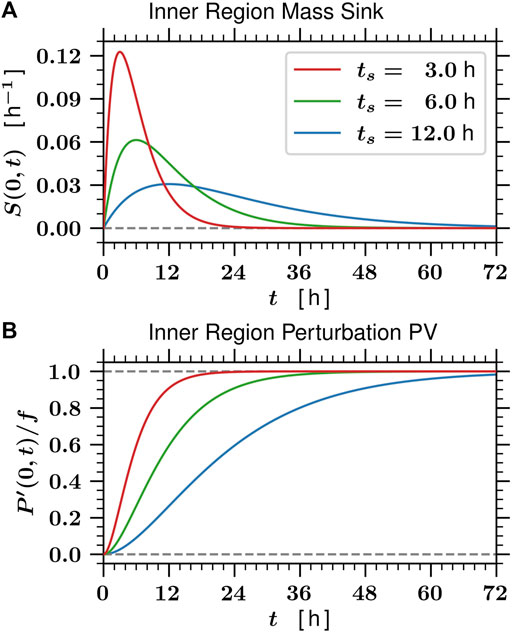
FIGURE 1. Panel (A) shows the time dependence of the mass sink S (r, t) for r ≤ r0, as given by the first entry in Eq. 13, with
Note that the relations Eq. 13 for S (r, t) and P′(r, t) result in Dirac delta functions on the right-hand sides of the ub and vb equations in Eq. 12. In Eq. 14, these become jump conditions on the radial derivatives of rub and rvb. The equations governing ub (r, t) and vb (r, t) for r ≠ r0 are homogeneous modified Bessel equations of order one, while the equation governing
As can be checked by direct substitution, the solutions of Eq. 14, along with the associated formula for the relative vorticity, are
where I0 and K0 are the zero order modified Bessel functions, and I1 and K1 are the first order modified Bessel functions. All four of the solution fields in Eq. 15 are continuous across r = r0 except ζb (r, t). The fact that the solutions ub (r, t) and vb (r, t) given in Eq. 15 satisfy the jump conditions can be checked by using the derivative relations d [rI1 (μr)]/rdr = μI0 (μr) and d [rK1 (μr)]/rdr = −μK0 (μr), and the Wronskian I0 (μr0)K1 (μr0) + K0 (μr0)I1 (μr0) = 1/(μr0). Using this Wronskian, it is easily seen that the jump in ζb across r = r0 is the same as the jump in P′. The maximum inflow occurs at r = r0 when t = ts, while the maximum azimuthal flow occurs at r = r0 as t → ∞ and the minimum fluid depth anomaly occurs at r = 0 as t → ∞.
We now examine actual solutions of the linear balanced model and the linear primitive equation model, using the parameters specified in Table 1 and the three forcing cases shown in Figure 1. The solutions of the linear primitive equation model (Eq. 7) are obtained numerically using a second-order, centered finite differencing scheme radially, a fourth-order Runge-Kutta scheme temporally, an outer radial boundary set at r = 5000 km, a 100 m radial resolution, and a 1 s temporal resolution. Select properties of the linear balanced solutions, specifically the values of ub (r0, ts), vb (r0, ∞), and

TABLE 2. The maximum radial inflow, maximum azimuthal wind, and final central depth anomaly for the three forcing cases ts =3,6,12 h, as computed from the linear balanced solutions (Eq. 15) using the specified and computed constants listed in Table 1. The maximum radial inflow is proportional to 1/ts, but the weaker inflows last progressively longer. Since the same volume of fluid is removed in each case, the final values vb (r0,∞) and
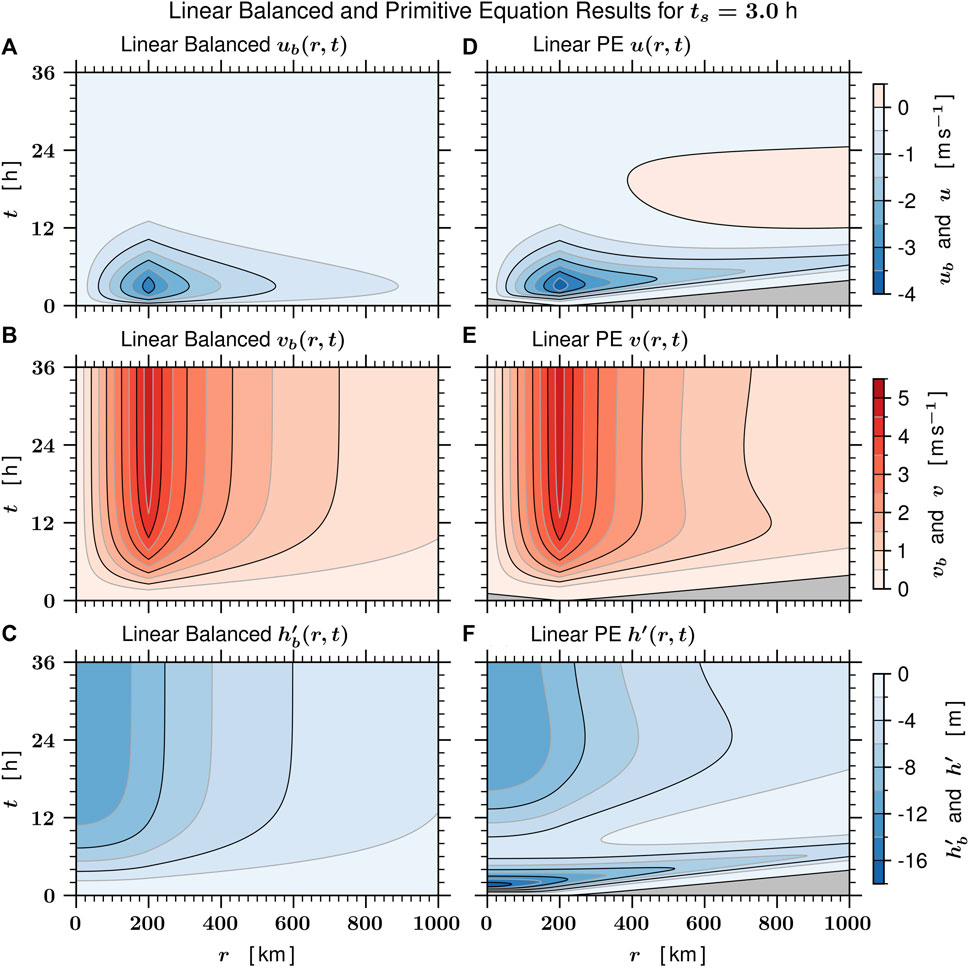
FIGURE 2. Panels (A-C) show the linear balanced solutions
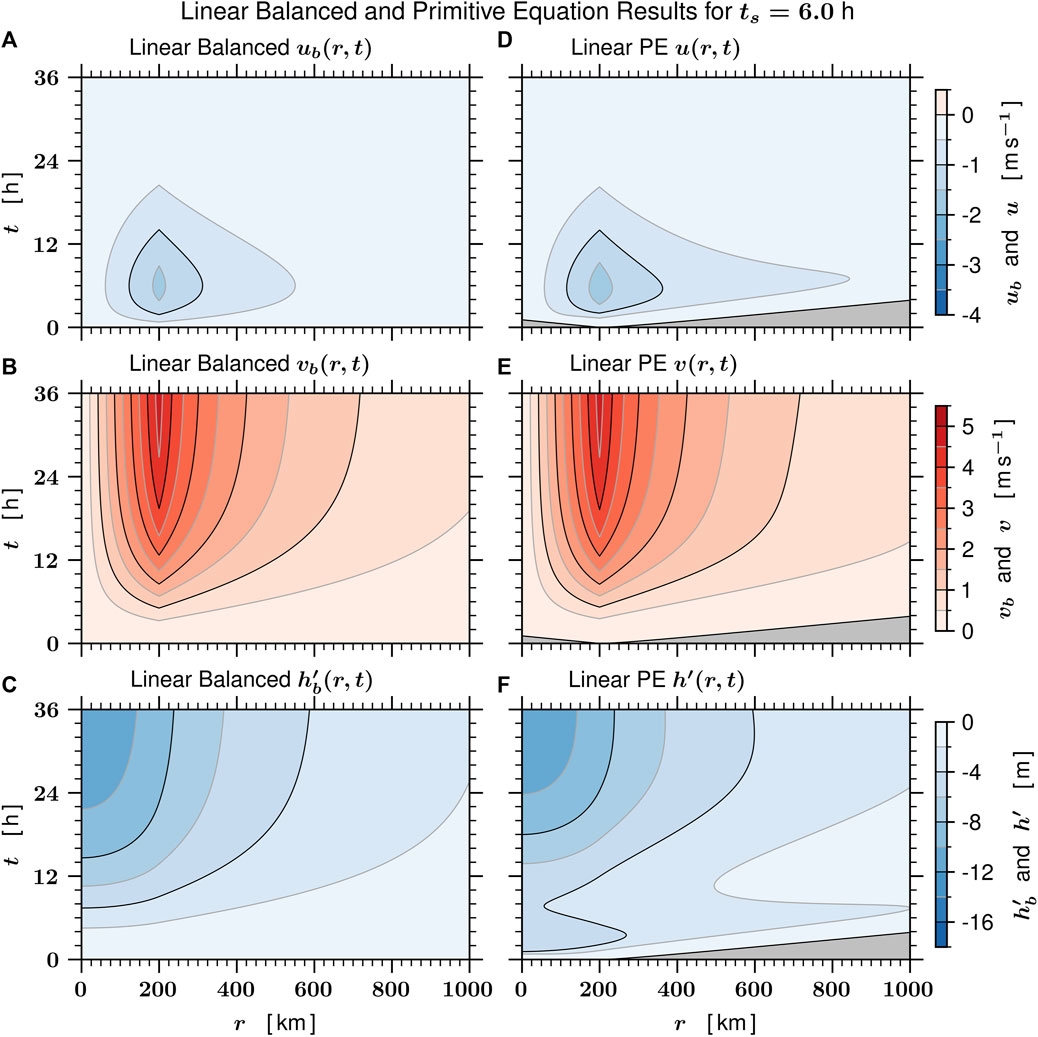
FIGURE 3. As in Figure 2, panels (A-C) show the linear balanced solutions
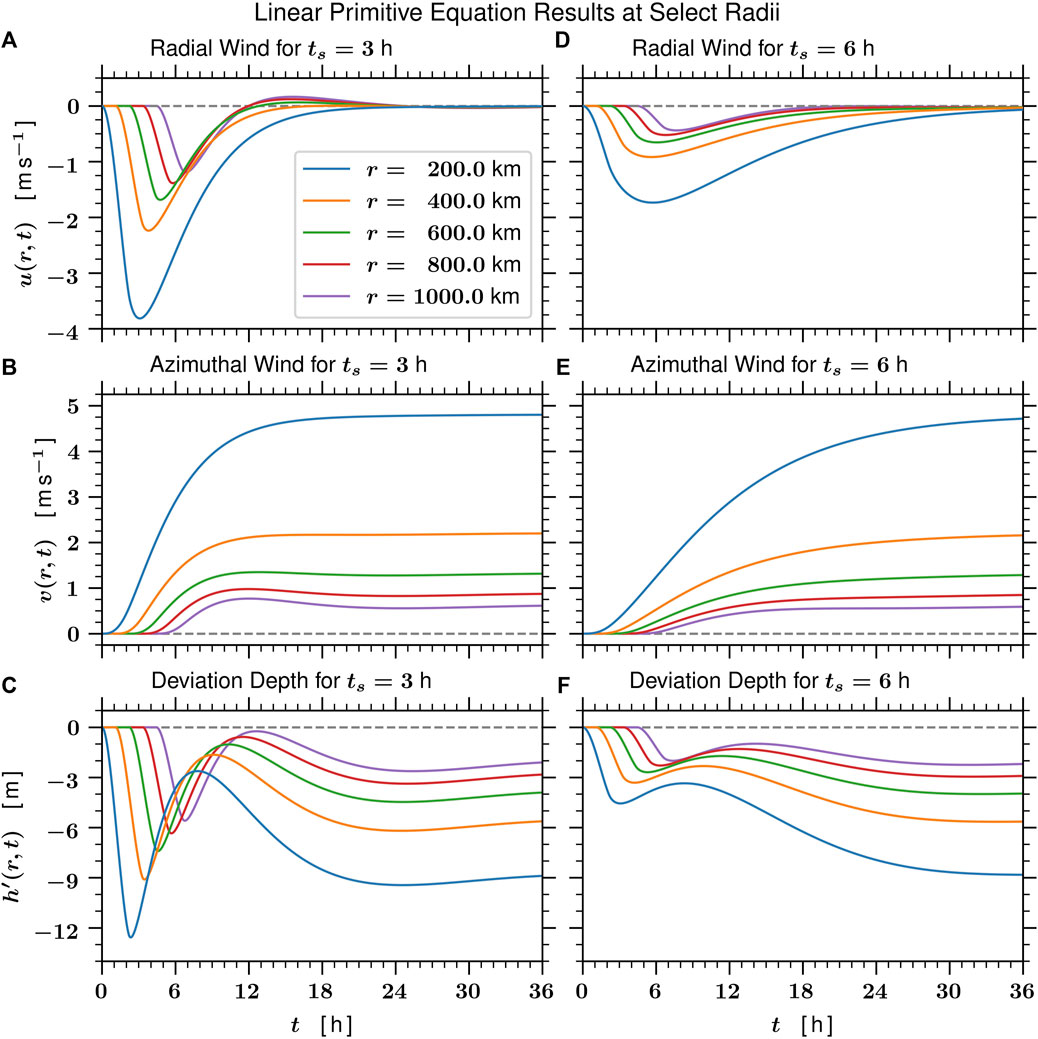
FIGURE 4. This figure shows the time dependence of the linear primitive equation solutions for the radial flow u (r, t), the azimuthal flow v (r, t), and the deviation depth h′(r, t) at the selected radii r =200,400,600,800,1000 km for the rapid forcing case ts =3 h (A-C) and for the less rapid forcing case ts =6 h (D-F). Note that these curves are simply vertical cross sections from Figures 2, 3. The outward propagating inertia-gravity wave packet is most readily apparent in the h′(r, t)-field, where it is immediately seen at r =200 km, and is seen, for example, with an approximately 4.5 h delay at r =1000 km. At each radius for the rapid forcing case (ts =3 h) these linear primitive equation solutions for h′(r, t) overshoot before coming into adjustment at a value that equals
The fundamental difference between the radial and azimuthal wind fields plotted in Figures 2, 3 can be understood as follows. The Dirac delta function on the right-hand side of the Klein-Gordon equation for u (r, t) and on the right-hand side of the diagnostic equation for ub (r, t) is characterized by a single pulse in time, so that both u (r, t) and ub (r, t) go to zero as t → ∞, similar to S (r, t). In contrast, the Dirac delta function on the right-hand side of the Klein-Gordon equation for v (r, t) and on the right-hand side of the invertibility principle for vb (r, t) is characterized by the same time behavior as the PV, so that both
The solution of the invertibility problem for vb (r, t) or the solution of the invertibility problem for
where the second equality follows from the cancellation of the time dependence of vb (r0, t) with the time dependence of P′(0, t). Thus, as long as the radius of the vortex core is less than a Rossby length (i.e., μr0 < 1), most of the PV anomaly in the core is partitioned to the vorticity field rather than to the mass field.
Since P′(r, t) grows as shown in Eq. 8, then |∂P′/∂r| at the PV edge increases with time and inertia-gravity waves can be excited there. Thus, the outer edge of a PV tower can be a region for the spontaneous generation of inertia-gravity waves. The inertia-gravity wave packets initiated at r = 200 km propagate inward and outward at
We may use the results of this section as the basis for the following physical picture. Each pulse of eyewall convective mass transport from the lower to the upper troposphere is accompanied by a corresponding pulse in the divergent circulation, which ratchets up the rotational circulation and ratchets down the fluid depth. According to the balanced model, the time dependence of the divergent circulation is in lock-step with the forcing S (r, t); this behavior is due to the mathematically elliptic character of the balanced divergent flow (i.e., action at a distance). Convection in the hurricane eyewall can fluctuate on a variety of time scales, so the secondary circulation is expected to fluctuate in a roughly similar fashion. If the convective fluctuations have a vertical structure similar to the first internal mode of the troposphere, the associated gravity wave speed is approximately 50 m s−1 (180 km h−1), so the information from eyewall convective fluctuations will propagate outward to 1000 km in approximately 4.5 h. For eyewall convective fluctuations having time scales larger than 6 h, the amplitude of the associated inertia-gravity wave packet is small, but for eyewall convective fluctuations with time scales less than 3 h, the amplitude of the associated wave packets may be considerably larger. In a continuously stratified fluid the inertia-gravity wave packets also propagate vertically, an important aspect that is further discussed in Section 5.
Although the linear analysis presented in this section provides a helpful guide to the nonlinear analysis of Section 4, the linearization used in Eq. 7 means that we are not analyzing true gradient adjustment and are restricting applications of the analytical results to situations where ζ < f, whereas real tropical cyclones involve situations in which ζ ∼ 100f. In Section 4 we examine the full nonlinear case.
4 Nonlinear dynamics in the Lagrangian coordinate
We now return to the nonlinear shallow water equations of Section 2, and perform numerical integrations using two types of forcing. The first type uses the mass sink defined by Eq. 13, i.e., the mass sink is confined within a disk of fixed radius (0 ≤ r ≤ r0). The second type, defined below in Eq. 27, uses a mass sink that is confined within the disk 0 ≤ R ≤ R0, where R is a Lagrangian coordinate that collapses as the vortex intensifies. As we shall see, there are some remarkable differences in the vortices that can be produced by these two types of forcing.
Figure 5 compares the nonlinear (left panels) and linear (right panels) numerical integrations using the identical parameter settings and forcing used to obtain the results shown in the right column of Figure 2. A major difference between the linear and nonlinear cases is the inward shift of the radius of maximum wind in the nonlinear case. In the linear case the azimuthal equation is (∂v/∂t) = −fu, so the radial distributions of (∂v/∂t) and − u are identical. In the nonlinear case the azimuthal equation is (∂v/∂t) = −(f + ζ)u, so the radial distribution of (∂v/∂t) is shifted inward when compared to the radial distribution of − u. During the first 24 h, the radius of maximum azimuthal wind shifts inward from 200 km to about 150 km and the maximum azimuthal wind approaches 5.3 m s−1. Thus, for 24 ≤ t ≤ 48 h, the average relative vorticity inside r = 150 km is approximately 1.4f, somewhat outside the range of validity for linear theory.
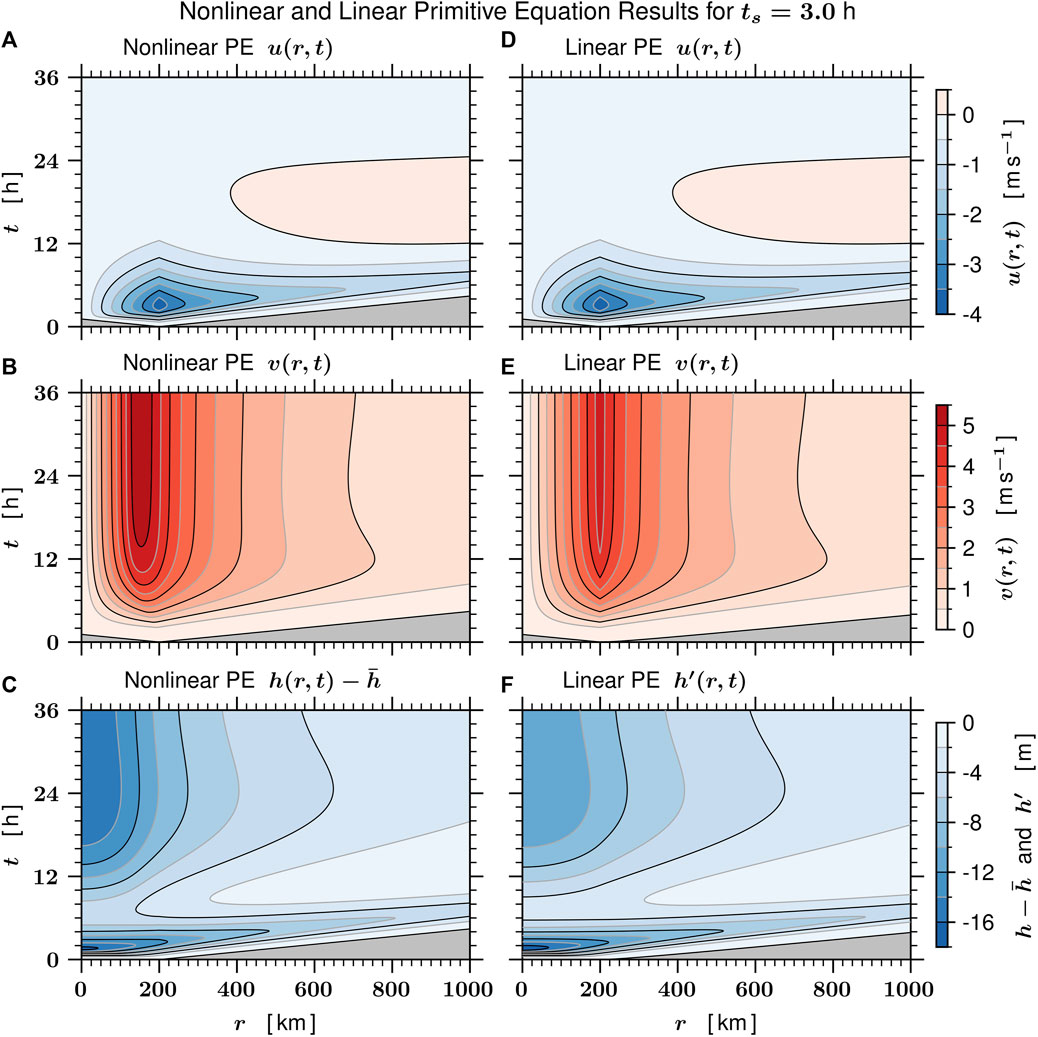
FIGURE 5. Panels (D-F) show the linear primitive equation solutions u (r, t), v (r, t), h′(r, t) for the rapid forcing case ts =3 h as shown previously in the right panels of Figure 2. Panels (A-C) show the nonlinear primitive equation solutions
Before discussing results of the second type of forcing, we note that insight into nonlinear model results can be obtained by transforming from the original independent variables (r, t) to the new independent variables (R, τ), where τ = t and R is defined by
we can easily confirm that transformations between r, v and R, V can be written in the form
Since the relative circulation 2πrv divided by the area πr2 is 2v/r, the factor (1 + 2v/fr) can be interpreted as the absolute circulation per unit area, measured in units of f, or equivalently, as the dimensionless average absolute vorticity inside the radius r. In the core of a hurricane we typically find (1 + 2v/fr) ∼ 100 and (1 − 2V/fR) ∼ (1/100), so that r ∼ (1/10) R and v ∼ 10 V. Because of the conservation of absolute angular momentum, the material derivative is (D/Dt) = (∂/∂t) + u (∂/∂r) = (∂/∂τ). As discussed below, this simplification of the material derivative will allow the PV equation to be directly integrated in time, so that the PV part of the dynamics can be treated analytically. The fact that (D/Dt) = (∂/∂τ) means that the radial advective effects u (∂u/∂r), u (∂v/∂r), u (∂h/∂r), and u (∂P/∂r) become implicit in the coordinate transformation r → R. If the solutions of the nonlinear shallow water equations are obtained in R-space, the effects of the radial advection terms do not appear until the final step of transforming the results back to r-space. Many of the characteristics of rapid intensification appear in this transformation R → r.
To further understand the transformation between v(r) and V(R), it is useful to consider the special case of a Rankine vortex. This example is simple because if V has a Rankine structure in R, then v has a Rankine structure in r, i. e.,
where r0, v0 are related to R0, V0 by
Thus, if we specify R0 and V0, then compute r0 and v0 from Eq. 20, we can plot V(R) and v(r) using Eq. 19. Figure 6 shows a family of Rankine vortices with R0 = 300 km and 0 ≤ v0 ≤ 65 m s−1 where isolines of the physical azimuthal wind v in the (r, v0)-plane are shown in the top panel and isolines of the transformed azimuthal wind V in the (R, v0)-plane are shown in the bottom panel. For a particular value of v0, the associated horizontal cross section from the top panel gives v(r) for that particular Rankine vortex and the same horizontal cross section from the bottom panel gives the corresponding V(R) for that same Rankine vortex. Since all the effects of radial advection are implicit in the R-coordinate, these often striking radial advective effects appear in the transformation back from R to r, i.e., in going from the bottom panel to the top panel in Figure 6. Some of the information in Figure 6 can also be presented in tabular form, as shown in Table 3. In constructing Table 3 we have chosen R0 = 300 km and a convenient set of values for v0, and then used Eq. 20 to determine r0 and V0. The determination of r0 is easily accomplished by noting that the two equations in Eq. 20 can be combined into
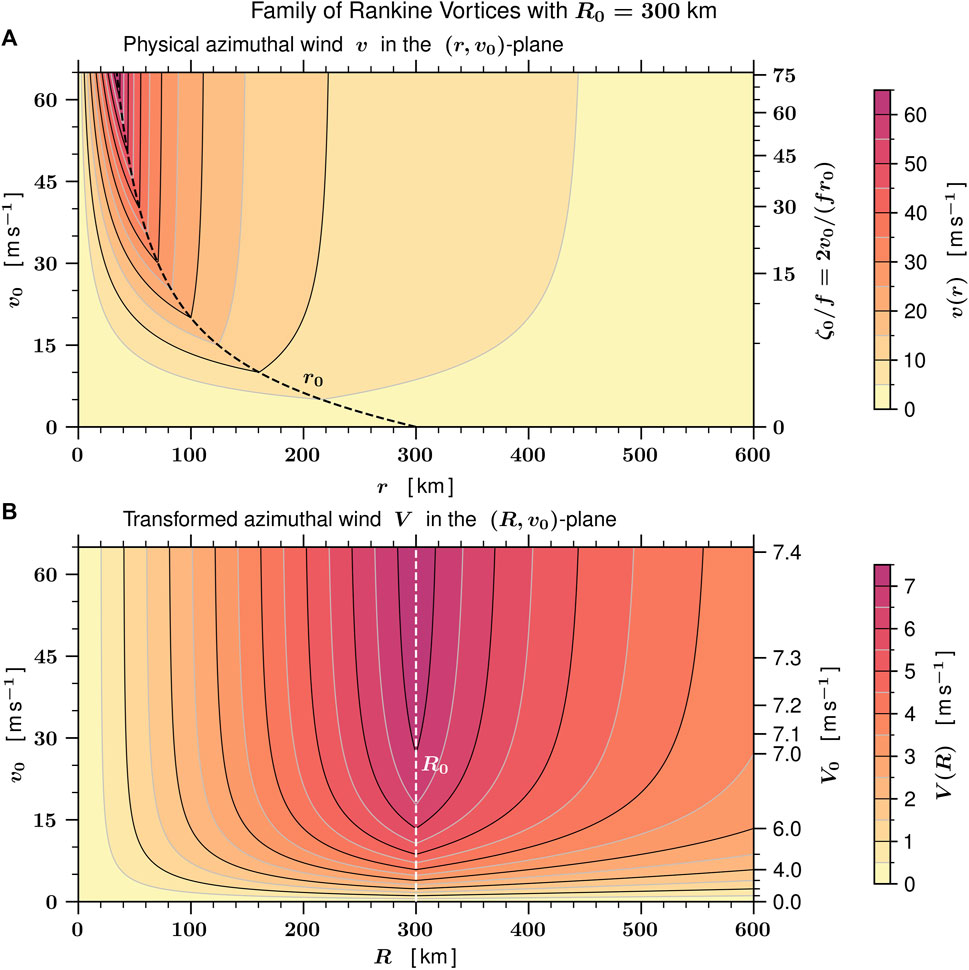
FIGURE 6. An illustration of the transformation relations Eq. 18 for the special case of a family of Rankine vortices, as defined in Eqs. 19, 20, with R0=300 km and f =5×10–5 s−1, so that

TABLE 3. Rankine vortex properties for a variety of storm categories, ranging from tropical depression (TD), to tropical storm (TS), to the five hurricane categories (C1–C5), and computed using Eq. 20 with R0=300 km and f =5×10–5 s−1. A range of values of the maximum physical azimuthal wind v0 is specified in the second column followed by computed values in the next three columns of the radius of maximum wind r0, the maximum transformed azimuthal wind V0, and the quantity 2v0/(fr0), which can be interpreted as the core’s relative vorticity, measured in units of f. Since the validity of the linearized dynamics discussed in Section 3 requires that 2v0/(fr0)<1, seven of the eight storm categories shown here fall outside the scope of linear theory.
Because of the conservation of absolute angular momentum, the material derivative is (D/Dt) = (∂/∂t) + u (∂/∂r) = (∂/∂τ). This allows the potential vorticity equation (Eq. 2) and its solution to be written as
where the potential depth h* is related to the potential vorticity by
Now consider the transformation of the nonlinear equations (Eq. 3). Using Eqs. 17, 18, and the definitions for R and V, the following useful relationships can be derived
Using Eq. 22 and the definitions for P and h*, the nonlinear equations (Eq. 3) become
The single, nonlinear partial differential equation for V (R, τ) can now be obtained by eliminating u from the system in Eq. 23. Taking (r/R) (∂/∂τ) of the V-equation in Eq. 23, and then making use of the u-equation, we obtain
which is the nonlinear generalization of the middle entry in Eq. 11. The initial conditions and boundary conditions in Eq. 24 result from the assumption that the evolving flow is due entirely to a localized forcing S (R, τ). The factors r and h appearing in Eq. 24 can be expressed in terms of V by
When the forcing term on the right-hand side of Eq. 24 is slow enough, the azimuthal flow remains close to gradient balance. Then, the r (∂/∂τ)[(1/r) (∂V/∂τ)] term becomes negligible and Eq. 24 simplifies to the following invertibility principle for the balanced transformed azimuthal wind Vb(R, τ):
Once again the h appearing in Eq. 26 can be expressed in terms of V by using Eq. 25.
In analogy with the argument given in Section 3 for the linear case, we now assume that the mass sink S (R, τ) vanishes for R > R0 and is horizontally uniform for R ≤ R0, where R0 is a specified constant. The time dependence of S (R, τ) is again assumed to be
and
where
where we have made use of hr dr = h*R dR, the assumption that S = 0 for R > R0, and the assumption that S (R, τ) and h*(R, τ) are independent of R for R ≤ R0. The last equality in Eq. 29 results from writing the first entry of Eq. 21 in the form (∂h*/∂τ) = −Sh*. The total volume of fluid removed is now obtained by integrating Eq. 29 over time, giving
where the second to last equality in Eq. 30 results from the use of Eq. 28 to show that
Since
A plot of P (0, ∞)/f as a function of
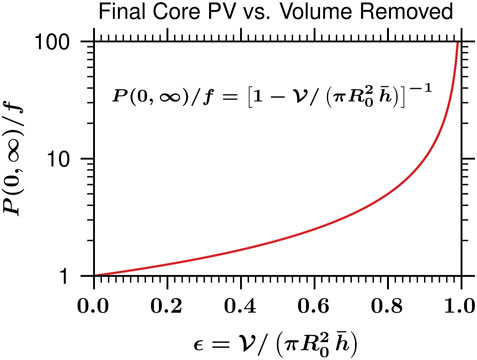
FIGURE 7. The final, dimensionless core potential vorticity P (0,∞)/f as a function of
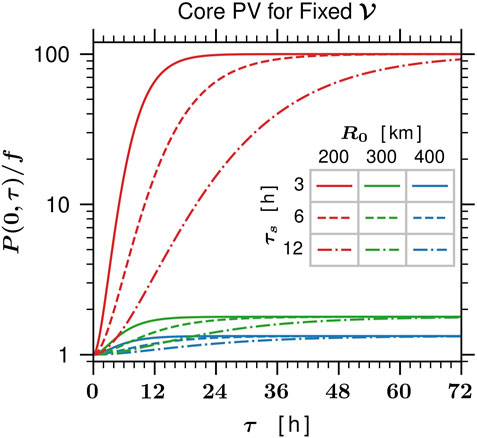
FIGURE 8. Plots of P (0, τ)/f, as given by Eq. 31 for the three choices τs =3,6,12 h, and for the three choices R0=200,300,400 km. The time evolution of P (0, τ)/f is plotted for 0≤ τ ≤72 h, and the volume parameter is chosen to be
As a final illustration of the remarkable intensification that can result with the second type of forcing, Figure 9 shows the results of two nonlinear primitive equation model integrations using the forcing in Eq. 27 with ts = 3 h. The right three panels show the time evolution of u (r, t), v (r, t), and
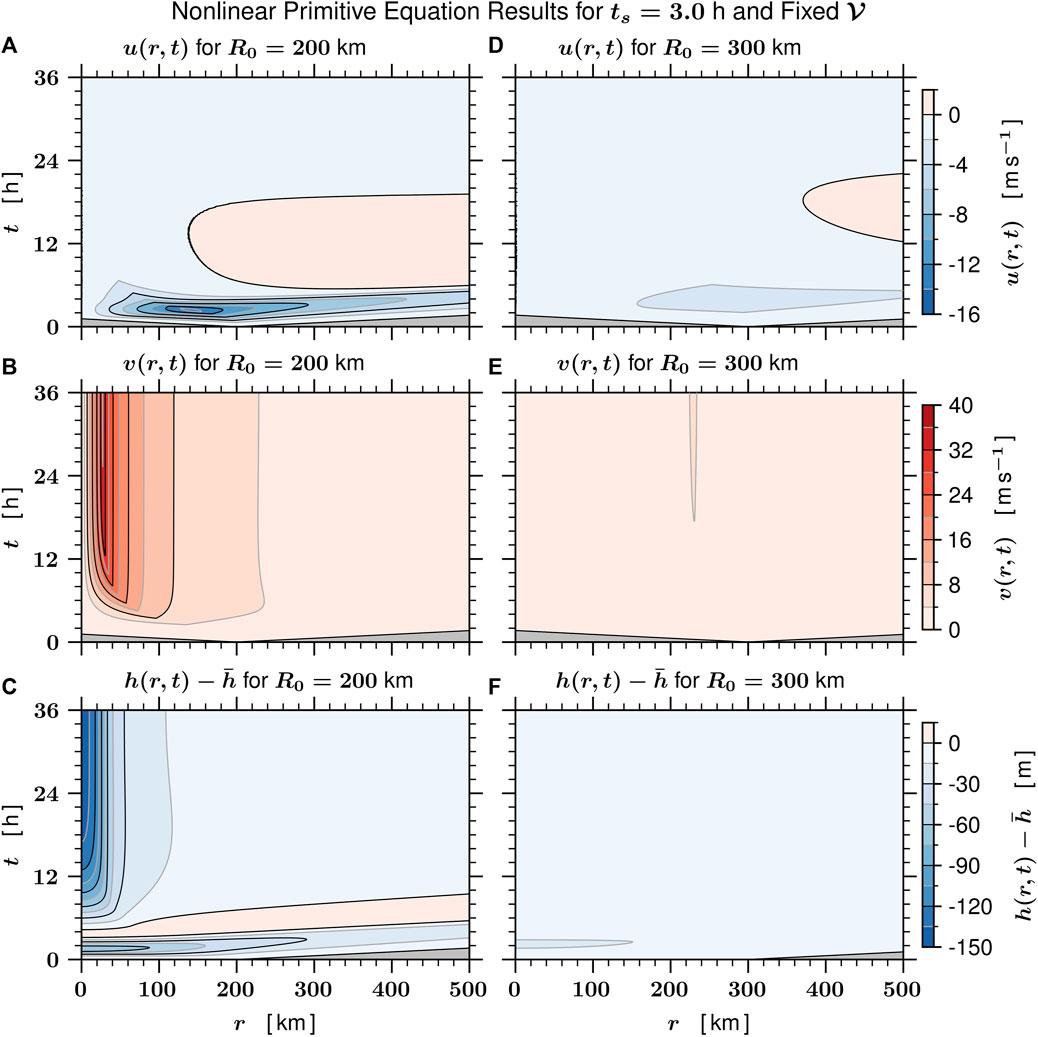
FIGURE 9. Panels (A–F) show the nonlinear primitive equation solutions obtained from Eq. 1 for the radial flow u (r, t), the azimuthal flow v (r, t), and the deviation depth
5 Concluding remarks
It is important to note that the simple axisymmetric shallow water model framework of this work does not include environmental effects and the frictional boundary layer, both of which certainly play a role in the rapid intensification process. Nevertheless, the nonlinear results presented here provide what we believe is an important part of the puzzle and are consistent with the notion that intensity forecasting is a difficult problem. For example, suppose (quite hypothetically) that we have a tropical cyclone with its core diabatic forcing (convection) confined by the absolute angular momentum surface R = R0. As can be see from Figures 7–9, if that diabatic forcing is able to remove 99% of the original mass inside that R0 surface over the next 24 h, then that tropical cyclone will undergo rapid intensification, but if the forcing only removes 50% of the original mass, then it will only slightly intensify. This does not mean that larger storms, i.e., storms with larger R0 values, cannot undergo rapid intensification, just that such a larger storm may require a longer incubation period before rapid intensification can occur.
Concerning the frictional boundary layer, consider a region bounded by two R-surfaces and two lower tropospheric θ-surfaces just above the boundary layer, i.e., an (R, θ)-pseudovolume. The removal of mass from such a pseudovolume involves both diabatic processes and boundary layer pumping. Boundary layer pumping may play a dual role, helping to keep the diabatic heating radially confined so that it collapses with the R-surfaces, but also limiting the percentage of mass that can be removed from that (R, θ)-pseudovolume. We might conclude that accurate determination of the location and magnitude of both frictional and diabatic mass fluxes is necessary for forecasting rapid intensification. The inclusion of environmental effects, such as vertical shear, would require fully three-dimensional arguments and thus a more detailed PV analysis or a generalized omega equation analysis (DeMaria, 1996; Wang and Zhang, 2003), which is an important topic for future research. While the present paper certainly does not solve the rapid intensification problem, perhaps it better defines the nature of the problem.
In closing we note that it can be argued that inertia-gravity waves generated by tropical cyclones are simply “the zero-PV icing on the cake” of what is fundamentally a balanced, potential vorticity phenomenon. Although there is merit to this argument, the observational monitoring of inertia-gravity waves as they propagate upward into the stratosphere and mesosphere can reveal information about eyewall convection. Some of this information might be of practical use in the prediction of rapid intensification. Inertia-gravity waves excited by inner core tropical cyclone convection can sometimes be observed at mesosphere levels by airglow observations from the Earth’s surface or from low Earth orbit (Miller et al., 2012, 2015). For example, Suzuki et al. (2013) described inertia-gravity wave patterns in the mesopause region caused by tropospheric convection in Typhoon Pongsona on 10 December 2002. Concentric rings of inertia-gravity waves in the OH airglow were observed simultaneously by all-sky imagers in a Japanese network of surface stations located between 31.0N and 43.5N. Such ground-based optical measurements require clear-sky conditions, so must be obtained at some distance from the tropical cyclone core in order to avoid persistent cirrus overcast. Such concentric mesospheric airglow waves can also be observed from space (Yue et al., 2014). As a recent example, Figure 10 shows a nocturnal Suomi-NPP VIIRS Day/Night Band image that captured concentric mesospheric airglow waves propagating upward from Super Typhoon Surigae near the time of its peak intensity on 17 April 2021. Concerning evidence from data at stratospheric levels, signatures of stratospheric inertia-gravity waves that have large vertical wavelengths can be found in Atmospheric Infrared Sounder (AIRS) radiance measurements in the 4.3 μm CO2 waveband. Such measurements detect the wave-induced perturbations in stratospheric temperature at levels between 30 and 40 km. Using such data, Hoffmann et al. (2018) searched for an association of stratospheric inertia-gravity waves with the intensification of tropical cyclones. They found a statistical correlation between stratospheric inertia-gravity wave activity and tropical cyclone intensification, lending support to the idea that variability in inertia-gravity wave signatures as a result of changing storm behavior may constitute a useful diagnostic tool for rapid intensification. This interesting possibility led Tratt et al. (2018) to propose a satellite mission concept for monitoring stratospheric inertia-gravity waves from geostationary orbit, which would open up the possibility of continuous monitoring. Although the theoretical results presented here are limited to shallow water dynamics, they do highlight some of the subtleties that are involved in linking inertia-gravity wave activity to rapid intensification. Thus, as research on this topic evolves with the use of full physics numerical models, it would not be surprising to encounter subtleties in the relationship of stratospheric inertia-gravity wave activity to rapid intensification.
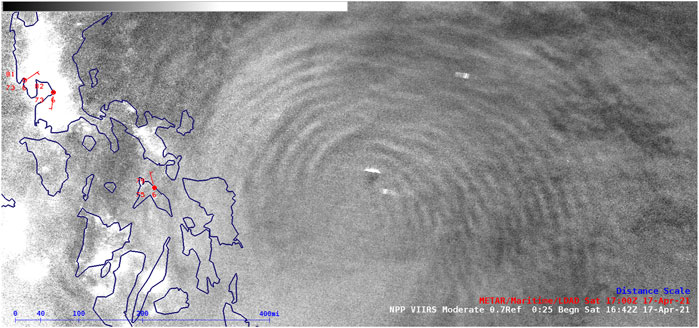
FIGURE 10. A nocturnal (several hours before sunrise) Suomi-NPP VIIRS Day/Night Band image (0.7 μm) showing concentric mesospheric airglow waves that have propagated upward from the convective core of Super Typhoon Surigae near the time of its peak intensity on 17 April 2021, when it was just east of the Philippines. From Bachmeier (2021).
An important result presented here is the nonlinear, inhomogeneous, Klein-Gordon equation (Eq. 24), which describes essential aspects of the rapid intensification of the potential vorticity and azimuthal wind fields in a tropical cyclone. Although this equation has an unfamiliar form, it may be of interest to note a relevant point made by Weinberg (1977, page 131) concerning results derived from sound physical and mathematical principles: “This is often the way it is in physics—our mistake is not that we take our theories too seriously, but that we do not take them seriously enough. It is always hard to realize that these numbers and equations we play with at our desks have something to do with the real world.”
Data availability statement
The original contributions presented in the study are included in the article/Supplementary Material. Further inquiries can be directed to the corresponding author.
Author contributions
WS researched and derived the scientific aspects of this work and wrote the majority of this paper. RT developed and ran the numerical models, created all of the figures, and provided editing and LaTeX support.
Funding
Our research has been supported by the National Science Foundation under grant AGS-1841326.
Acknowledgments
We thank Chris Slocum and Mark DeMaria for their helpful comments and Eric Hendricks, Jonathan Vigh, and Chris Rozoff for sharing with us their ideas on how PV concepts associated with a forced, balanced, axisymmetric shallow water model can be used for understanding short-term tropical cyclone intensification and wind structure changes. We would also like to thank the two reviewers for their useful comments and suggestions.
Conflict of interest
The authors declare that the research was conducted in the absence of any commercial or financial relationships that could be construed as a potential conflict of interest.
Publisher’s note
All claims expressed in this article are solely those of the authors and do not necessarily represent those of their affiliated organizations, or those of the publisher, the editors and the reviewers. Any product that may be evaluated in this article, or claim that may be made by its manufacturer, is not guaranteed or endorsed by the publisher.
Supplementary material
The Supplementary Material for this article can be found online at: https://www.frontiersin.org/articles/10.3389/feart.2022.1038351/full#supplementary-material
References
Bachmeier, S. (2021). Rapid intensification of super Typhoon Surigae. Wisconsin: University of Wisconsin. CIMSS Satellite Blog. Available at: https://cimss.ssec.wisc.edu/satellite-blog/archives/date/2021/04/16 (Accessed 04 25, 2022).
Cahn, A. (1945). An investigation of the free oscillations of a simple current system. J. Meteor. 2, 113–119. doi:10.1175/1520-0469(1945)002<0113:AIOTFO>2.0.CO;2
DeMaria, M., Sampson, C. R., Knaff, J. A., and Musgrave, K. D. (2014). Is tropical cyclone intensity guidance improving? Bull. Am. Meteorol. Soc. 95, 387–398. doi:10.1175/BAMS-D-12-00240.1
DeMaria, M. (1996). The effect of vertical shear on tropical cyclone intensity change. J. Atmos. Sci. 53, 2076–2088. doi:10.1175/1520-0469(1996)053<2076:TEOVSO>2.0.CO;2
Doyle, J. D., and Ferek, R. (2017). Tropical cyclone intensity experiment (TCI). AMS Special Collection. Boston: American Meteorological Society. Available at: https://journals.ametsoc.org/collection/TCI (Accessed 10 07, 2022).
Hack, J. J., and Schubert, W. H. (1986). Nonlinear response of atmospheric vortices to heating by organized cumulus convection. J. Atmos. Sci. 43, 1559–1573. doi:10.1175/1520-0469(1986)043<1559:NROAVT>2.0.CO;2
Hendricks, E. A., Vigh, J. L., and Rozoff, C. M. (2021). Forced, balanced, axisymmetric shallow water model for understanding short-term tropical cyclone intensity and wind structure changes. Atmosphere 12, 1308. doi:10.3390/atmos12101308
Hoffmann, L., Wu, X., and Alexander, M. J. (2018). Satellite observations of stratospheric gravity waves associated with the intensification of tropical cyclones. Geophys. Res. Lett. 45, 1692–1700. doi:10.1002/2017GL076123
Hoskins, B. J., McIntyre, M. E., and Robertson, A. W. (1985). On the use and significance of isentropic potential vorticity maps. Q. J. R. Meteorol. Soc. 111, 877–946. doi:10.1002/qj.49711147002
Martinez, J., Bell, M. M., Rogers, R. F., and Doyle, J. D. (2019). Axisymmetric potential vorticity evolution of Hurricane Patricia (2015). J. Atmos. Sci. 76, 2043–2063. doi:10.1175/JAS-D-18-0373.1
Miller, S. D., Mills, S. P., Elvidge, C. D., Lindsey, D. T., Lee, T. F., and Hawkins, J. D. (2012). Suomi satellite brings to light a unique frontier of nighttime environmental sensing capabilities. Proc. Natl. Acad. Sci. U. S. A. 109, 15706–15711. doi:10.1073/pnas.1207034109
Miller, S. D., Straka, W. C., Yue, J., Smith, S. M., Alexander, M. J., Hoffmann, L., et al. (2015). Upper atmospheric gravity wave details revealed in nightglow satellite imagery. Proc. Natl. Acad. Sci. U. S. A. 112, E6728–E6735. doi:10.1073/pnas.1508084112
Möller, J. D., and Smith, R. K. (1994). The development of potential vorticity in a hurricane-like vortex. Q. J. R. Meteorol. Soc. 120, 1255–1265. doi:10.1002/qj.49712051907
Musgrave, K. D., Taft, R. K., Vigh, J. L., McNoldy, B. D., and Schubert, W. H. (2012). Time evolution of the intensity and size of tropical cyclones. J. Adv. Model. Earth Syst. 4, 15. doi:10.1029/2011MS000104
Ooyama, K. (1969). Numerical simulation of the life cycle of tropical cyclones. J. Atmos. Sci. 26, 32–40. doi:10.1175/1520-0469(1969)026<0003:NSOTLC>2.0
Schubert, W. H., and Alworth, B. T. (1987). Evolution of potential vorticity in tropical cyclones. Q. J. R. Meteorol. Soc. 113, 147–162. doi:10.1002/qj.49711347509
Schubert, W. H., Hack, J. J., Silva Dias, P. L., and Fulton, S. R. (1980). Geostrophic adjustment in an axisymmetric vortex. J. Atmos. Sci. 37, 1464–1484. doi:10.1175/1520-0469(1980)037<1464:GAIAAV>2.0.CO;2
Suzuki, S., Vadas, S. L., Shiokawa, K., Otsuka, Y., Kawamura, S., and Murayama, Y. (2013). Typhoon-induced concentric airglow structures in the mesopause region. Geophys. Res. Lett. 40, 5983–5987. doi:10.1002/2013GL058087
Tratt, D. M., Hackwell, J. A., Valant-Spaight, B. L., Walterscheid, R. L., Gelinas, L. J., Hecht, J. H., et al. (2018). Ghost: A satellite mission concept for persistent monitoring of stratospheric gravity waves induced by severe storms. Bull. Am. Meteorol. Soc. 99, 1813–1828. doi:10.1175/BAMS-D-17-0064.1
Wang, X., and Zhang, D.-L. (2003). Potential vorticity diagnosis of a simulated hurricane. Part I: Formulation and quasi-balanced flow. J. Atmos. Sci. 60, 1593–1607. doi:10.1175/2999.1
Weinberg, S. (1977). The first three minutes: A modern view of the origin of the universe. New York: Basic Books, 188.
Keywords: tropical cyclone, rapid intensification, inertia-gravity waves, potential vorticity, axisymmetric shallow water model, Klein-Gordon equation
Citation: Schubert WH and Taft RK (2022) Tropical cyclone rapid intensification and the excitation of inertia-gravity waves on the edges of an evolving potential vorticity structure. Front. Earth Sci. 10:1038351. doi: 10.3389/feart.2022.1038351
Received: 06 September 2022; Accepted: 11 October 2022;
Published: 08 November 2022.
Edited by:
Eric Hendricks, National Center for Atmospheric Research (UCAR), United StatesReviewed by:
Zifeng Yu, China Meteorological Administration, ChinaBinod Sreenivasan, Indian Institute of Science (IISc), India
Copyright © 2022 Schubert and Taft. This is an open-access article distributed under the terms of the Creative Commons Attribution License (CC BY). The use, distribution or reproduction in other forums is permitted, provided the original author(s) and the copyright owner(s) are credited and that the original publication in this journal is cited, in accordance with accepted academic practice. No use, distribution or reproduction is permitted which does not comply with these terms.
*Correspondence: Richard K. Taft, cmljay50YWZ0QGNvbG9zdGF0ZS5lZHU=
 Wayne H. Schubert
Wayne H. Schubert Richard K. Taft
Richard K. Taft